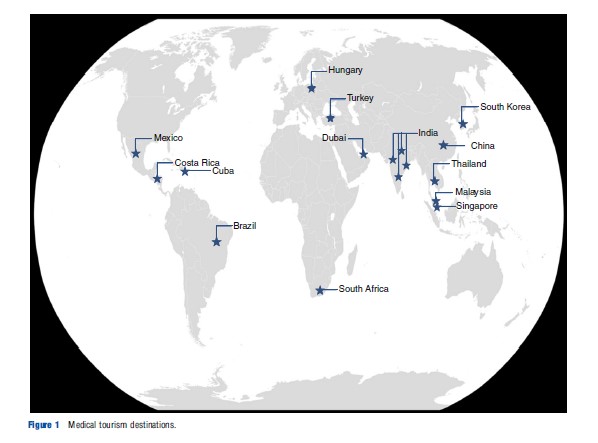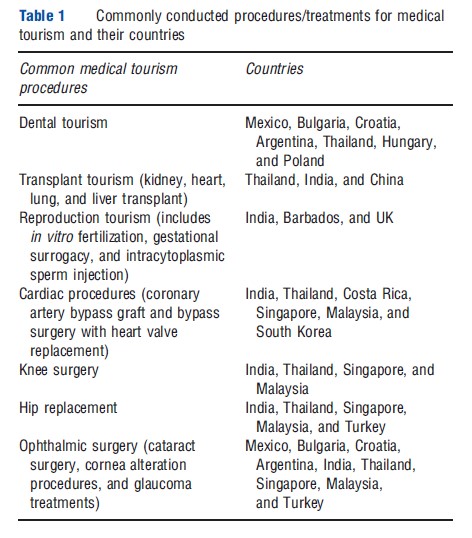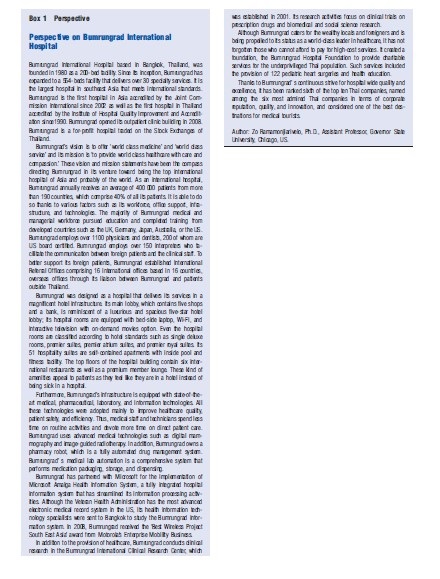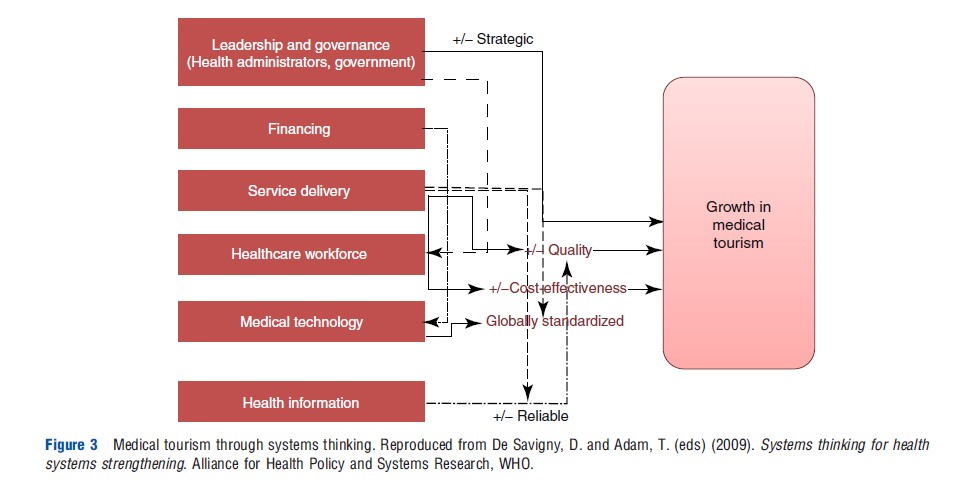Globalization has inevitably become part of all industries, as we observe the economy stretch worldwide due to cheaper travel, better communication methods, and common solutions to problems. Over the past decade a healthcare practice that has emerged with an unimagined scale of magnitude as a multibillion dollar industry is the global medical tourism industry. Privatization and commercialization of conventional home country or region-based healthcare has been redefined in a global market. Medical tourism (also often referred to as international medical tourism) is generally defined as the travel of patients seeking healthcare services outside the main local healthcare coverage area.
According to sources, the number of medical tourists will rise from approximately 10.5 million in 2011 to 23.2 million by 2017. Some predict global revenue approximately between $40 and $60 billion, with different growth rates estimated over the next 10 years, some at 20% annual growth. Some reports estimate specific area growth, such as worldwide surgical volume at 60 000 patients every year. The most obvious benefit of medical tourism is cost savings for consumers, which typically range from 40% to 90%. For example, heart bypass that may cost approximately $180 000 in the US can be rendered at $10 000 in India or Thailand. Including first class air fare and four-star hotel accommodations for recovery, the savings are routinely more than 60%.
However, one needs to remember that medical tourism is not a new phenomenon, ancient civilizations and historians have recorded the travel of patients across regions and countries searching for appropriate treatment and better care. For example, Greeks traveled to spas known as ‘Asklepia’ in the Mediterranean for purification and spiritual healing; for over 2000 years foreign patients have traveled to the Aquae Sulis reservoir built by the Romans in what is now the British town of Bath; and Chinese and Indian scholars traveled across countries to seek more knowledge of diseases and conditions bringing patients with them. In the early nineteenth century, sanatoriums attracted tuberculosis patients to pristine mountain air such as Davos, Switzerland.
For the past few decades, outstanding facilities, such as Cleveland Clinic and Mayo Clinic, have attracted medical tourists to developed countries such as US, especially wealthy patrons from the developing world. However, worth noting is the new pattern of reversed care destination where patients from developed countries travel to seek medical services in developing countries such as India, Thailand, Malaysia, Chile, Argentina, Philippines, Jordan, South Africa, and others (Figure 1). These countries offer state-of-the-art technology and facilities, employ US-trained physicians, and concierge healthcare services at a fraction of costs that would have otherwise been incurred in the developed countries (low labor costs and overheads making it affordable). Other factors contributing to the growth of medical tourism include, but are not limited to, financial mobility, free trade, technological advances, cheap transportation, more resources, and rapid communications. Patients unable to gain prompt access to services due to a number of reasons, such as restricted insurance policies, long waiting time, and unavailable treatment options have started traveling beyond their borders to receive the care of preferences. Additionally, ‘word of mouth’ promotion by recent medical tourists, careful marketing, and interests from health insurance companies are some other drivers of medical tourism.

To attract patients from developed countries, medical tourism packages include procedures (Table 1) with pre-established prices, air fare, accommodation, ground transportation, concierge treatment, food, recuperation therapy, and supplementary trips to popular destinations. Often these packages are well coordinated by medical tourism companies representing care delivery organizations in the host countries.

Medical Tourism Through A Systems Thinking Perspective
Systems thinking is an approach that reveals the underlying characteristics and relationships of systems. It uses comprehensive suite of tools and approaches to map, measure, and understand a system and its dynamics with the environment. Its utility in understanding and integrating complex, real-world settings makes it the right strategy for explaining the growth in medical tourism industry. To understand the medical tourism industry, it is imperative to understand the complex effects, synergies, and emergent behaviors of various stakeholders affecting this economic explosion. Additionally, researchers have discussed the benefits of using the systems thinking approach in understanding healthcare systems as these systems are self-organizing, constantly changing, tightly linked, governed by feedback, nonlinear, history dependent, counter-intuitive, and resistant to change.

The main stakeholders in the global healthcare marketplace include hospitals (private and public), patients, stand-alone clinics, governments, medical tourism companies, airlines, hotels, health administrators, and healthcare providers (Figure 2). However, first, it is important to understand how the medical tourism industry fits in the healthcare system. World Health Organization (WHO) defines a health system as, ‘consists of all organizations, people and actions whose primary intent is to promote restore or maintain health.’ The goal is ‘improving health and health equity in ways that are responsive, financially fair, and make the best, or most efficient, use of available resources.’ WHO further identifies six systems building blocks that are used as a framework to apply systems thinking to medical tourism. These blocks serve as framework for understanding the medical tourism and effect of stakeholders in the service. The blocks have been identified as: Service delivery, health workforce, health information, medical technologies, health financing, and leadership and governance. These blocks form an integrated relationship that creates interactions in the medical tourism industry. Thus, using this framework and systems thinking approach an attempt is made to understand the world of medical tourism (Figure 3) (Box 1).
- Service delivery: The most effective medical tourism hospitals are the ones that provide services that are superior quality, reliable, timely, accessible, cost effective, and globally identical to some of the best in the world.
- Health workforce: The workforce is well trained, highly efficient, and reliable. Additionally, the workforce needs to be affordable to maintain the low cost structure. The combination of these attributes is commonly found in healthcare professionals, providing care services in the medical tourism industry.
- Health information: These hospitals ensure that the consumers are provided with current, relevant, and non-asymmetric information. Gaining trust of patients through transparency is what these hospitals aim to achieve at the point of interest initiation. The advancement of information and communications technologies allows consumers to access health information from various electronic sources at their fingertips.
- Medical technologies: To build competitiveness and illustrate advanced medical capabilities, medical tourism providers have invested in medical technologies that are most advanced, cost effective, scientifically sound, and safety and quality focused.
- Health financing: The health financing system is entitled to providing affordable, necessary medical services to patients. Evidently, medical tourism ‘provides incentives for providers and users to be efficient’ simultaneously.
- Leadership and governance: Strong leadership and effective governance drive strategic thinking to create new care delivery models that meet consumer demands and to generate an accountable care environment via policy and regulation oversight.


Economic Drivers Of Medical Tourism
As mentioned in the section Growth of Medical Tourism, globalization of markets and services serve as a strong enabler of healthcare trades between developed countries and developing countries. Specifically, it forces the global healthcare markets to be smaller and interconnected and opens opportunities for the movement of consumers and resources (i.e., healthcare professionals, medical and information technology, pharmaceutical supplies, capital funding, and international laws and regulations) across national borders. As a result, medical tourism has influenced the economic discourse of healthcare services consumption and production. Like other economic goods, the growth of medical tourism inherently rests on the fundamental economic principles of demand, supply, price, and value.
Because a transaction of medical tourism involves a number of relevant stakeholders, such as patients, providers, insurance companies, governments of the patient’s countries, and government of the hosting countries (Figure 2), it is complicated to describe the economic drivers by a stakeholder. This article will discuss the economic drivers through the demand and supply lenses in which the multifaceted perspectives of different stakeholders can be well incorporated. Note that the following discussions will focus on the outbound medical tourism from developed countries to developing or hosting countries. Healthcare systems across countries around the world have confronted different unique challenges, which fundamentally result from how the systems are set up.
Multiple US federal mandates and initiatives have been enacted with the aims of sustainably bending the healthcare cost curve and improving access and quality of care. Meanwhile, a number of Americans are struggling with their chronic or acute illnesses every day, requiring necessary medical treatments, many of whom are uninsured or underinsured. Healthcare providers, especially hospitals, are under a lot of pressures caused by reimbursement cuts and new payment models. The result is increasing operating expenses while being required by law to stabilize any patients present at their facilities regardless of their insurance status. Hospitals that keep taking on the burdens caused by unpaid services are in financial distress causing some to discontinue their operations. This results in a negative domino effect on the other existing hospitals. In addition, underinsured patients are not authorized for certain procedures and cannot afford the difference between the charges and amount their payers reimburse the provider. As a result, price plays a major role for uninsured and underinsured Americans to receive proper treatments, forcing them to search for options overseas where a similar procedure plus travel and accommodation expenses cost much less. Lack of cost transparency for the medical care provided and uncontrolled escalation of medical service and technology costs add more challenges within the healthcare market.
Canada and England are samples of other Organization for Economic Cooperation and Development (OECD) countries confronting their own issues of waiting time. Although the government will take care of sick patients, they are required to wait a number of weeks or months for certain medical procedures causing unbearable pains and discomforts. In addition, some medical services such as fertility and stem-cell treatments have yet to be legalized or approved in many western countries, leaving patients with no choice but to seek the treatments available elsewhere. Given that these medical tourism facilities are well equipped with the state-of-the-art technologies and staffed with western-trained providers, some patients perceive them as providing higher quality of treatments when compared to local providers. The abundance of information technology also allows patients to gather information on medical treatment options from various sources, which assist their decision making process and help protect themselves from information asymmetry and provider-induced demand. As a result, there exist unmet demands of medical services among citizens of these developed countries. Price, unavailable treatment options, long waiting time, and ability to make a decision based on alternative preferences are some of the major drivers on the demand of medical tourism. In summary, price and value in medical tourism can generally be reflected through the notion that world-class quality care is rendered to patients from developed countries at third world prices.
When there is a demand, there will always be an opportunity for a new market, and those who recognize it and have capabilities to supply the needs can take the pie. The supply side of this medical tourism equation is obviously reflected through the hosting or developing countries that provide medical services to the patients from developed countries with unmet needs. Healthcare delivery organizations in developing countries have quickly grasped on the concept of medical tourism and these untapped demands, emphasizing on quality of care and world-class customer services. Some perceive it as a new business development strategy when domestic private patients have turned to publicly funded healthcare systems such as academic health centers where high quality and advanced care is rendered at a lower price. Some countries have seen the great economic potential of medical tourism turned it into the national agenda and supported the provider organizations both financially and policy-wise (e.g., India and Thailand). For example, opening of more health tourist visa approvals, more subsidies on ventures encouraging tourists in the country, and legalization of certain medical procedures such as surrogacy.
The main competitive advantage that these provider organizations have over their counterparts in the developed countries is the cost of labor and supplies. Labor is a major operating cost for healthcare delivery organizations. Because labor costs in these developing countries, even for healthcare professionals, are much lower than those in developed countries, these organizations are operating at a fraction of the cost incurred by their western counterparts, allowing them to develop attractive pricing strategies. In addition, the medical and pharmaceutical supplies in developing countries are at a much lower negotiated price, part of which is due to international trade agreements.
Owing to the dramatic success in the medical tourism industry within a relatively short timeframe, there is an increasing trend in partnership and investment between health systems in the developed countries and medical tourism providers in developing countries, resulting in the flow of capital funding to accelerate the growth of medical tourism. Over the years, medical tourism has expanded its client base from only out-of-pocket individuals to patients with private or employer insurance because both sides share a win-win situation. The potential revenue streams from these groups of patients have led to different types of arrangements between insurance companies in developed countries and providers in developing countries. As a result, low operating costs and increasing capital are two main factors driving the growth of medical tourism on the supply side.
Health Policy Issues In Medical Tourism
Although medical tourism has created tremendous economic gains to the hosting countries and health benefits to the patients receiving care, it at the same time has undergone a number of legal, social, and ethical criticisms and forfeiting challenges. The emerging trade of medical services brings forth a number of regulatory and policy implications at international and country levels affecting both developed and developing countries. Given that medical tourism is relatively in its infancy and merely merits dramatic attention in recent years, there is no existing law or regulation that specifically aims to enforce appropriate actions, penalize misconducts in medical treatments, and prevent future wrongdoing around this new pattern of medical practice.
Certain regulations and policies aim at supporting the medical tourism industry. There exist some international accreditation organizations such as the Joint Commission International (based in the US) and Trent Accreditation Scheme (based in UK–Europe) from which medical tourism organizations seek accreditation to demonstrate their commitment to high-quality care and patient safety. By being recognized by the world-renowned accreditation bodies, these care delivery organizations can not only provide a level of assurance and comfort to patients traveling from developed countries but also leverage the accreditation as a competitive advantage that could also attract local patients.
To support the growth of medical tourism, some developing countries have relaxed their visa process or established a special type of visa for patients seeking medical treatments in the countries. Additionally, with the great attempt to bend the healthcare cost curve, the US Congress recently held a Senate hearing on the promise of medical tourism titled ‘The Globalization of Health Care: Can Medical Tourism Reduce Health Care Costs?’ while there is also a push for Medicare and Medicaid to reimburse medical tourism services. Furthermore, insurance companies have caught on the trend and started incorporating medical tourism into their plans, hoping to decrease the cost burdens they would otherwise have borne should the patients were treated in the US.
However, medical tourism has incurred unintended consequences for which no laws and regulations have yet been prepared. Privacy and security of patient information is of great concern. Although the information created or captured on the US soil is protected by the Health Insurance Portability and Accountability Act, healthcare organizations in other countries are not bound by the law, which in turn makes it difficult to handle any violations. Not only patients from developed countries but also the citizens of the hosting countries could be negatively impacted by medical tourism. The economics doctrine was established on the notion of scarcity where limited resources can never fulfill indefinite wants and needs. As a result, when resources are redirected to serve the needs of spillover patients from the developed countries, there will be negative consequences to the unmet needs of basic healthcare services among the consumers in the hosting countries. This poses highly concerned threats to the local patients, especially among the people with financial constraints. Statistics have shown that the ratio of medical providers to patients in developing countries is much lower than that of developed countries. In addition, on top of the existing issue of external brain drain, the heavy recruitment of highly skilled, experienced, western-trained healthcare practitioners into medical tourism facilities has driven a more severe incidence of provider shortage in the public health system of the developing countries (i.e., internal brain drain). Although there is currently no empirical study that shows that the magnitude of medical tourism impacts on provider shortage and healthcare access of consumers in the developing countries, some anecdotal evidence point to the stark increasing disparities.
Without an effective policy set forth by home country governments or international bodies, the issues could have further implications on social gaps and potentially threaten the health-related goals put in place by the countries or international organizations such as WHO and United Nations. To ensure the mitigation of negative effects, home country governments and international regulatory bodies must work independently and cooperatively to prioritize an understanding of these issues and subsequently develop policies that address these arduous obstacles in both short and long term.
The Future Of Medical Tourism
Medical tourism has generated global competition in the delivery of healthcare market. In this competition, the more expensive and resourceful countries are increasingly disadvantaged. However, one cannot remain a nonparticipating player in this lucrative opportunity. As a result, a number of frontrunners in the US healthcare have expanded their strategic coverage to compete for market share in medical tourism. For example, Philadelphia International Medicine is building a hospital in Korea; Harvard University has partnered with India’s Wockhardt Hospital and the United Arab Emirates to create the Dubai Healthcare City; and The Johns Hopkins University and Tufts University have opened hospitals in India. Such collaboration and partnership have propelled the image of affordable and high-quality care to new heights.
In the long run, medical tourism may also help insurance providers and employers reduce their costs and provide their employees with alternatives for satisfactory coverage. Only a few insurers offer care overseas, but they have already reported remarkable savings. For example, Blue Cross/Blue Shield of South Carolina gives customers a medical tourism option through its Companion Global Healthcare and even offers coordination of foreign care for preexisting and noncovered procedures. Employers large and small are beginning to offer incentives to their employees to have routine care done outside the country, observing considerable savings. For example, Hannaford, a US grocery chain, found that sending its employees to Singapore for knee or hip replacements lowered the price from $43 000 to $9000.
Medical tourism challenges the ability of nation-states and national governments to control affairs within their own jurisdiction. The lack of legal options for patients choosing healthcare overseas, ethical and social justice issues of traveling abroad for organ transplant and reproductive tourism and concerns about large international hospitals providing level of care unaffordable for citizens is a concern raised by opponents. To address these concerns new international steps are taken among a coalition of countries resulting in the Declaration of Istanbul on Organ Trafficking and Transplant Tourism in May, 2008. Nonprofit organizations promoting international medical travel vouching for quality healthcare are also growing; one of such organizations is Medical Tourism Association that currently has 20 000 members and a slick website and magazine. Additionally, organizations such as Joint Commission International – the international division of The Joint Commission, have been working with healthcare organizations, ministries of health, and global organizations in more than 80 countries. Conferences such as the World Medical Tourism and Global Health Conference are being held every year and are attended by representatives from major international medical centers looking for business, Western firms coordinating medical travel and care, and third-party payers and insurance companies seeking ways to contain costs.
On a general note, globalization of healthcare in the form of medical tourism has several advantages:
- Economies of scale: The production of medical services in an efficient and standardized format encourages value creation in healthcare delivery.
- Better consumer purchasing power: Apart from quality, the central focus of this industry is cost-efficiency, which gives consumers (patients) more control of their treatment options and destinations.
- Faster adoption of innovative healthcare treatments and technologies: The presence of innumerable competitors acts as driver for the early adoption of evidence-based innovative treatment plans and options. It additionally also creates more acceptability of the services that are provided by hospitals.
- Emergence of global market segments: As the industry grows, more clustering of this industry is being observed. Presently, the Asian region (India, Thailand, Malaysia, and Singapore) seem to be sprouting medical tourism hospitals at an exponential speed.
- Development of synergies: The global scale of the healthcare industry is also an opportunity for transfer of ideas on healthcare products and treatments from one country to another. Additionally, the global marketing creates more experience in operating in multicultural and diverse environments.
The key to success for medical tourism therefore lies in the strategic global economic growth, focusing on how revenue from worldwide patient travel translates into output, jobs, and income. It will provide an opportunity to both developing and developed countries. Although developing countries will benefit from the travel resulting in revenue generation from the healthcare services provided, developed countries will benefit from the competitiveness of the market as a stop point to reflect on their cost, quality, and accessibility issues in providing their citizens value-driven healthcare. Even though medical tourism is confronting some social and ethical challenges, it without a doubt is an explicit example of international economics in action where the flow of consumers and resources beyond local boundary promotes an affordable, accessible, and quality healthcare environment.
References:
- Bookman, M. Z. and Bookman, K. R. (2007). Medical tourism in developing countries. United States: Palgrave Macmillan.
- Carrera, P. M. and Bridges, J. F. (2006). Globalization and healthcare: Understanding health and medical tourism. Expert Review of Pharmacoeconomics and Outcomes Research 6(4), 447–454.
- Ehrbeck, T., Guevara, C. and Mango, P. D. (2008). Mapping the market for medical travel. McKinsey Quarterly. https://www.mckinseyquarterly.com/ Mapping_the_market_for_travel_2134 (accessed 17.02.13).
- Herrick, D. M. (2007). Medical tourism: Global competition in health care. NCPA Policy Report. http://www.ncpa.org/pub/st304 (accessed 17.02.13).
- Horowitz, M. D., Rosensweig, J. A. and Jones, C. A. (2007). Medical tourism: Globalization of the healthcare marketplace. Medscape General Medicine 9(4), 33.
- Turner, L. (2010). ‘Medical tourism’ and the global marketplace in health services: US patients, international hospitals, and the search for affordable health care. International Journal of Health Services 40(3), 443–467.
- Unti, J. A. (2009). Medical and surgical tourism: The new world of health care globalization and what it means for the practicing surgeon. Bulletin of American College of Surgery 94(4), 18–25.
- Woodman, J. (2008). Patients beyond borders: Everybody’s guide to affordable, world-class medical travel. United States: Catawba Publishing LLC.
- York, D. (2008). Medical tourism: The trend toward outsourcing medical procedures to foreign countries. Journal of Continuing Education in the Health Professions 28(2), 99–102.